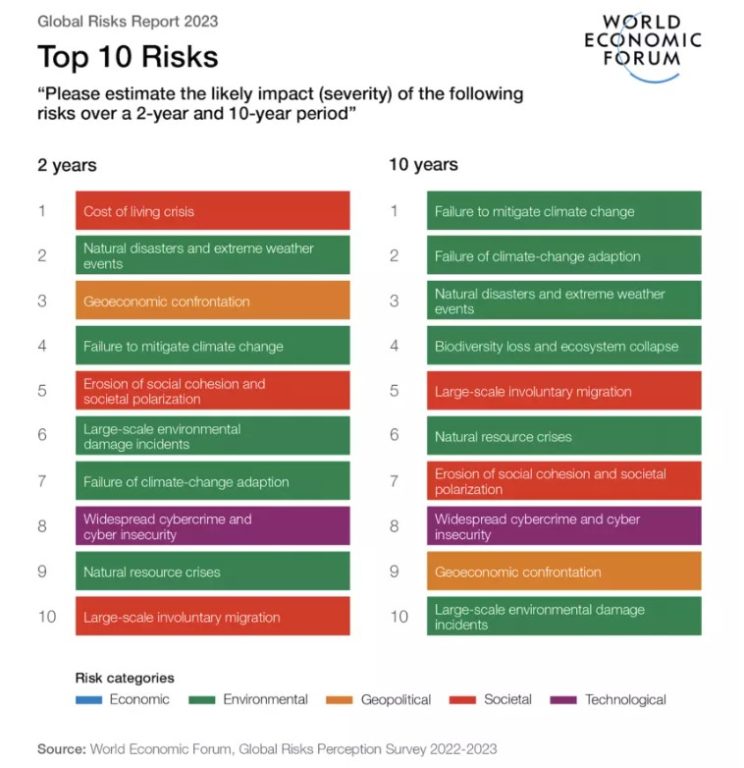HR risks for 2023: Cost of living, mental health and labor supply
According to the World Economic Forum.
Why You Should Care
The world is on the brink of a recession.
But the cost of living crisis isn't the only challenge employers need to take note of.
Find out how to respond to the wellbeing, employment and cybersecurity risks in the short and long-term.
The first two years of the 2020s were full of disruption, largely wrought by the COVID-19 pandemic.
However, 2022 brought new challenges, notably a war on the European continent between Russia and Ukraine, which sent inflation soaring and triggered economic instability around the world.
As a result, it is no surprise that the World Economic Forum (WEF)’s 2023 global risk report identified the cost of living crisis as the biggest challenge over the next two years.
The report stated: “The economic after effects of COVID-19 and the war in Ukraine have ushered in skyrocketing inflation, a rapid normalization of monetary policies and started a low-growth, low-investment era.
“Even if some economies experience a softer-than-expected economic landing, the end of the low interest rate era will have significant ramifications for governments, businesses and individuals.”
This, in turn, contributes to other risks, rising poverty and hunger, and therefore social and political unrest (including possible state collapse).
This explains why that geo-economic confrontation and erosion are not seen at the WEF as just short-term challenges, but risks over the next decade.

Given the likelihood of polycrises emerging, especially since these social and economic challenges exist in the context of extreme environmental risks, the WEF is clear that resilience is key, but that preparedness must focus on addressing a multitude of risks.
While governments must take a lead on resilience and preparedness, employers (and particularly HR teams) need to take action around the main risk between now and 2025: the cost of living crisis.
While debt challenges may prevent organization-wide wage increases, there are other innovative solutions organizations can try to mitigate financial crisis at the individual level. Examples include bonuses, better financial wellbeing resources, more discount perks on everyday items or even earned wage access.
Deep dive into mental health risks
The WEF report also focused in on the healthcare challenges in the aftermath of the COVID-19 pandemic.
“Global public health is under growing pressure and health systems around the world are at risk of becoming unfit for purpose,” stated the report.
“The COVID-19 pandemic further amplified ever-present specters and emerging risks to physical and mental health, including antimicrobial resistance, vaccine hesitancy and climate-driven nutritional and infectious diseases.”
But there is another huge challenge both in the short and long-term: mental health. Over the next two years, the WEF ranked the erosion of mental wellbeing as the 23rd top risk – it was 25th over the next decade. This is a real issue for business bottom lines.
According to the report, severe mental deterioration will see the “widescale spread of mental health disorders or rising inequality globally across multiple demographics, which negatively impacts wellbeing, social cohesion and productivity”.
Also, remember that burnout and stress has been a major cause of the ‘Great Resignation’ – employees no longer want work to impact their mental wellbeing, instead they want a better work-life balance.
So to mitigate the risks of high attrition and a productivity crisis, employers need to step up, lead with empathy and treat their employees as individuals. It is time to dial up your wellbeing benefits.
The WEF links the wellbeing risks with issues around social cohesion, violence and employment crises.
Focusing in on employment crises, the WEF sees this as a clash between labor supply and demand, as well as issues around underemployment, the erosion of workers’ rights and stagnating wages.
Labor shortages, plus attacks on workers rights and wage challenges, will not only be a challenge in the short-term, but over the next decade. Employment crises are the 19th biggest risk over the next two years, but it will remain a challenge (23rd) into 2030.
While employers are figuring out these employment crises, they are also grappling with figuring out their future of work models.
“The mass move to home working during the pandemic has led to tracking of workers through cameras, keystroke monitoring, productivity software and audio recordings – practices which are permitted under data-protection legislation in certain circumstances, but which collect deeper and more sensitive data than previous mechanisms”, noted the WEF report.
Given this proliferation of data, organizations need to be hot on cybersecurity, particularly as the WEF found that cybercrime is on the rise and will be a top 10 risk in the short-term and long-term.
Make sure your cybersecurity policies are up to date, and all your employees are trained and vigilant.
The International Festival of HR is back! Discover amazing speakers at UNLEASH America on 26-27 April 2023.
Sign up to the UNLEASH Newsletter
Get the Editor’s picks of the week delivered straight to your inbox!

Chief Reporter, UNLEASH
Allie is an award-winning business journalist and can be reached at alexandra@unleash.ai.
Contact Us
"*" indicates required fields
Partner with UNLEASH
"*" indicates required fields